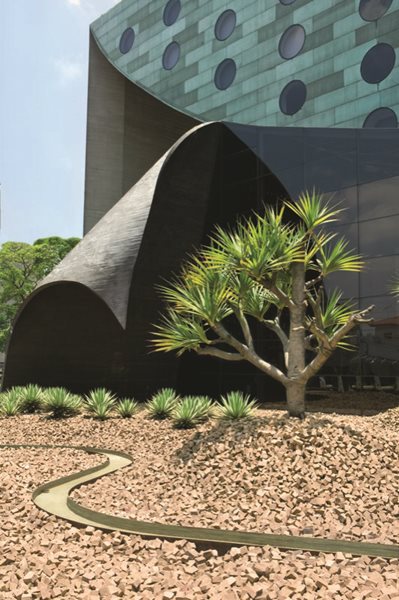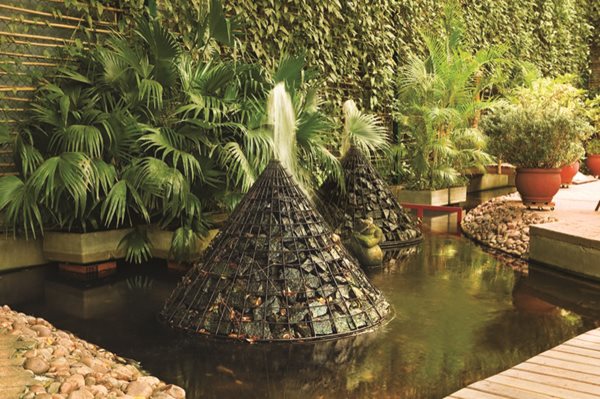Sao Paulo, Brazil Gardens
South America's largest city, São Paulo has evolved into a hotbed for some of the most innovative landscape designs in the country — and the world
By Donna Dorian

Photo by: Jon Whittle
Muralist, painter, ecologist and naturalist Roberto Burle Marx (1909-1994) has been referred to as the spontaneous explosion who launched modernist landscape architecture in Brazil. Like his design for Rio's Copacabana, this 1980s rooftop winter garden for the Safra bank headquarters in São Paulo composes an abstract mural when seen from above.

Photo by: Jon Whittle
Gilberto Elkis designed this riveting, sustainable landscape as equal accompaniment to São Paulo’s post-modern, copper-clad Hotel Unique, by Brazil’s foremost architect, Ruy Ohtake.

Photo by: Jon Whittle
Landscape architect Gilberto Elkis

Photo by: Jon Whittle
Conceived as a desert oasis and composed of a small collection of tropical trees and shrubs, stone and water, it gathers its strength and sense of permanence from the bold simplicity of architectonic forms.

Photo by: Jon Whittle
Ornamented with Phoenix palms, one of Rosa Kliass’ rooftop gardens for the Fleury Laboratory functions as both a promenade and a seating area for employees.

Photo by: Jon Whittle
The fountain at the Fleury Laboratory is inset into the center of the building like a well.

Photo by: Jon Whittle
The plan to transform an unfinished private garden by Burle Marx into São Paulo’s Burle Marx Park was overseen by Rosa Kliass.

Photo by: Jon Whittle
Landscape architect Rosa Kliass

Photo by: Jon Whittle
The sculptural permanence of this dramatic outdoor room is underlined by the selection of evergreen plants — Pandanus utilis, Dracaena arborea, Phyllostachys pubescens, Buxus sempervirens and the spring-flowering Neomarica caerulea.

Photo by: Jon Whittle
At his São Paulo office, Alex Hanazaki stands among some of his favorite plants.

Photo by: Jon Whittle
For the entrance garden of this São Paulo residence, Isabel Duprat counterpoints sculpted bamboo reaching toward the sky with river stones at rest in the pool.

Photo by: Jon Whittle
A similar approach is at play in Duprat's Isamu Noguchi-inspired stone garden at the entrance to the Torre Sul building, where the elements are harmoniously balanced.

Photo by: Jon Whittle
Landscape architect Isabel Duprat

Photo by: Jon Whittle
Whether he is designing a garden for São Paulo’s chic Fasano restaurant, or a private getaway for film director Hector Babenco, Rodrigo Oliveira proves his mettle as a self-proclaimed naturalist. Babenco’s garden exemplifies Oliveira’s approach: After crossing an ipe bridge into an opening in a wall, the house is discovered in the midst of a small rainforest.

Photo by: Jon Whittle
Although Maria Cecília Gorski has designed landmark gardens throughout São Paulo and Brazil, she particularly delights in making gardens and playgrounds for children. For the family restaurant Praça São Lourenço, which doubles as a playground, she created a water course punctuated with mini water-spouting volcanoes, a treehouse and a planting of fruit trees.

Photo by: Jon Whittle
Known for both his public and commercial work, Benedito Abbud has overseen some 5,200 projects throughout South America. His design for Brascan Century Plaza — with its angular waterways, outdoor sculpture and 100 pau ferro, sibipuruna and pau brasil trees (from which the country takes it name) — brought a sense of community to the neighborhood.

Photo by: Jon Whittle
After Sérgio Menon and Caterina Poli pooled their talents in horticulture and architecture to form Grama & Flor Paisagismo, they quickly made a name as designers of sensory-filled outdoor rooms. For this garden, they created “a little beach with bromeliads and sand.” Holes in the roof allow light in and the royal palms to be viewed from the bedroom above.




